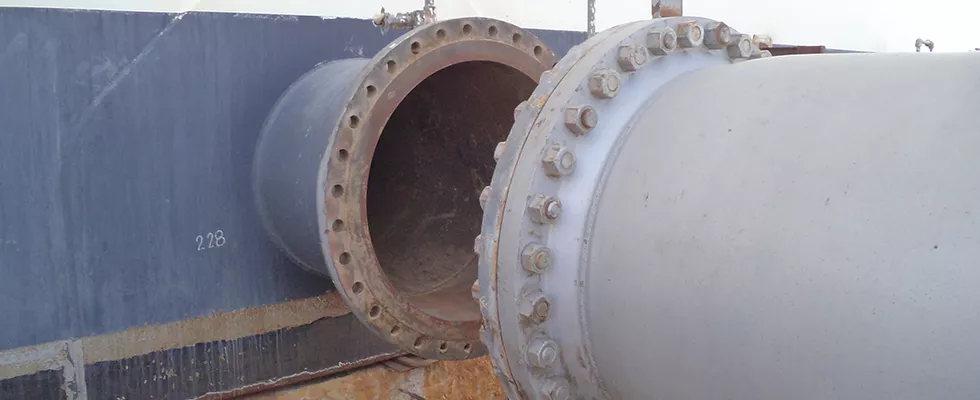Project Description
The Tank at Tobrok Terminal project involves the construction and installation of a high-capacity storage tank at the Tobrok oil and fuel terminal, located in Tobruk, Libya. This strategic infrastructure project is designed to enhance the terminal’s ability to store, manage, and distribute crude oil or refined fuel products efficiently and safely. The terminal plays a vital role in the energy supply chain, and the installation of this tank will significantly increase its storage capacity, optimize operational efficiency, and improve logistical support for fuel distribution in the region.
Project Overview:
The Tank at Tobrok Terminal project includes the design, fabrication, and erection of a large-scale storage tank that will meet both operational demands and international safety and environmental standards. The tank will be equipped with advanced monitoring and safety systems to ensure the secure handling and storage of fuel, minimizing environmental risks and maximizing operational uptime.
Key Activities and Components:
- Site Preparation and Assessment:
- Site Evaluation: A thorough site assessment is conducted to evaluate the existing infrastructure, soil conditions, environmental factors, and proximity to other terminal facilities. This helps determine the ideal location for the tank within the terminal to optimize space and ensure safe operation.
- Excavation and Grading: Excavation and grading work is carried out to prepare the foundation area, ensuring the ground is level, stable, and suitable for supporting the weight and size of the tank.
- Environmental and Safety Compliance: Detailed environmental impact assessments (EIAs) are conducted to ensure the tank’s installation complies with local regulations and international standards. This includes mitigating any risks to surrounding areas, especially in terms of potential leaks or spills.
- Tank Design and Fabrication:
- Tank Design: The design of the tank will be tailored to meet the storage needs of the terminal, considering factors such as volume, product type (crude oil or refined fuel), and local environmental conditions. The tank will be designed to international standards, such as API (American Petroleum Institute) 650 for welded steel tanks and UL (Underwriters Laboratories) standards.
- Fabrication: The tank will be fabricated in sections at a specialized facility, using high-quality, corrosion-resistant materials such as carbon steel or stainless steel. The fabrication process will include welding, quality testing, and preparation for shipment to the installation site.
- Modular Design: In some cases, the tank may be built using modular sections to facilitate easier transport and quicker assembly on-site.
- Foundation Construction:
- Reinforced Concrete Foundation: A reinforced concrete foundation is constructed to provide a stable and secure base for the tank. This foundation is designed to support the weight of the fully loaded tank and withstand environmental factors such as ground movement and seismic activity.
- Secondary Containment Systems: The foundation may include a secondary containment system, such as a concrete dike or berm, to contain any accidental spills or leaks, preventing fuel from reaching the surrounding environment.
- Tank Erection and Installation:
- Transportation: The fabricated tank sections are transported to the Tobrok terminal site via specialized transport vehicles. The transport route is planned in advance to avoid any obstructions and ensure safe delivery of components.
- Assembly and Welding: Once on-site, cranes and heavy-lifting equipment are used to position and assemble the tank sections on the prepared foundation. The sections are welded and bolted together to form a single, unified storage tank.
- Fittings and Connections: The tank is equipped with necessary fittings such as inlet and outlet pipes, valves, manholes, vents, and pressure relief valves. These components ensure the proper filling, emptying, and venting of the tank.
- Mechanical and Piping Systems:
- Fuel Transfer System: The tank will be integrated into the terminal’s existing fuel transfer and distribution system, which includes pipelines, pumps, and other mechanical systems necessary for the efficient movement of fuel to and from the tank.
- Safety Systems: Key safety features such as emergency shutdown valves, leak detection systems, and fire suppression systems (such as foam or water deluge systems) will be installed to prevent accidents and ensure rapid response in the event of an emergency.
- Instrumentation and Monitoring: The tank will be equipped with instrumentation to monitor fuel levels, temperature, pressure, and other parameters in real-time. This data will be transmitted to a centralized control room for continuous monitoring and operational optimization.
- Testing and Commissioning:
- Pressure Testing: Prior to commissioning, the tank will undergo rigorous pressure testing to ensure it is leak-proof and can safely withstand the internal pressures of stored fuel.
- Functional Testing: The mechanical, piping, and safety systems will be tested to verify proper functionality. This includes testing of the transfer systems, safety alarms, and emergency response systems.
- Commissioning and Handover: After successful testing, the tank will be fully commissioned, and the terminal will begin its full-scale operation. A final inspection is carried out to ensure compliance with all safety, environmental, and regulatory standards.
- Environmental and Safety Considerations:
- Leak Prevention and Spill Containment: The tank will be equipped with leak prevention and spill containment systems to minimize environmental risks. This may include secondary containment features such as berms, sumps, or drainage systems.
- Fire Prevention: The installation will include advanced fire protection systems, such as foam-based fire suppression, to safeguard against the risk of fire or explosion, especially in the event of a fuel leak or spill.
- Monitoring and Maintenance: The project will also include the development of a comprehensive monitoring and maintenance plan to ensure the tank remains operational for years to come, with regular inspections, cleaning, and repairs as necessary.
Project Objectives:
- Increased Storage Capacity: Enhance the Tobrok terminal’s storage capacity for crude oil or refined fuels, improving the terminal’s ability to handle higher volumes of fuel.
- Safety and Compliance: Install the tank with a focus on safety, ensuring compliance with local regulations, international standards, and environmental protection requirements.
- Operational Efficiency: Integrate the tank into the existing fuel distribution network, optimizing operational processes and facilitating the smooth flow of fuel through the terminal.
- Long-Term Durability: Build a robust, durable tank designed to withstand environmental factors, wear and tear, and long-term use, minimizing the need for maintenance and extending the life of the terminal infrastructure.
The Tank at Tobrok Terminal project will provide critical infrastructure to enhance the terminal’s fuel storage capacity, improving both operational efficiency and safety while meeting the growing energy demands of the region. By using advanced technologies and strict adherence to safety and environmental standards, the project will ensure the long-term success and sustainability of the Tobrok terminal as a vital hub for energy distribution.

